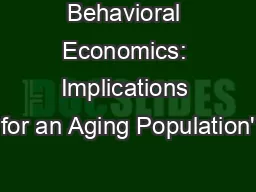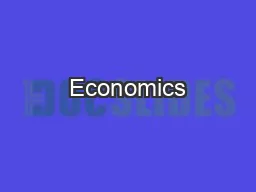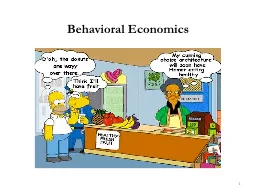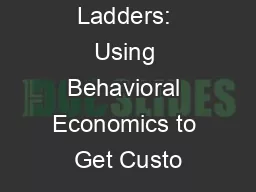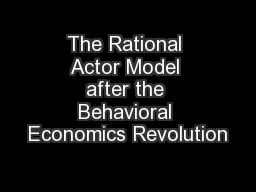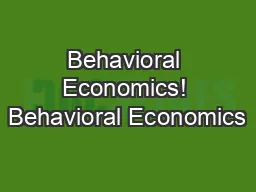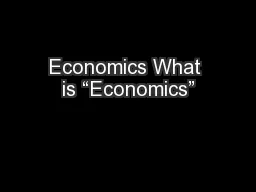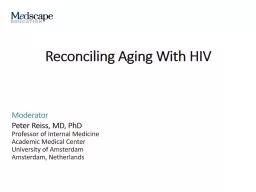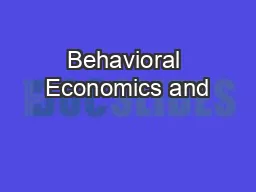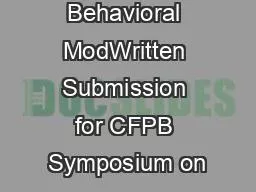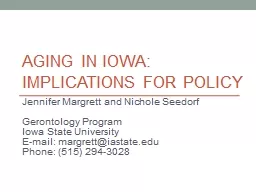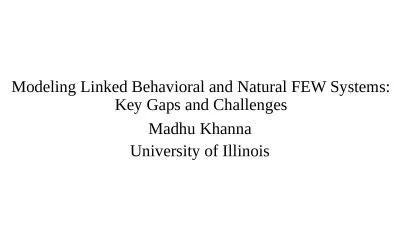PPT-Behavioral Economics: Implications for an Aging Population'
Author : liane-varnes | Published Date : 2016-07-16
Anand S Rao September 23 rd 2008 For more information contact Anand S Rao Partner AnandRaodiamondconsultantscom Mobile 6176338354 Agenda What is Behavioral Economics
Presentation Embed Code
Download Presentation
Download Presentation The PPT/PDF document "Behavioral Economics: Implications for a..." is the property of its rightful owner. Permission is granted to download and print the materials on this website for personal, non-commercial use only, and to display it on your personal computer provided you do not modify the materials and that you retain all copyright notices contained in the materials. By downloading content from our website, you accept the terms of this agreement.
Behavioral Economics: Implications for an Aging Population': Transcript
Anand S Rao September 23 rd 2008 For more information contact Anand S Rao Partner AnandRaodiamondconsultantscom Mobile 6176338354 Agenda What is Behavioral Economics BE What is the relevance of BE in HealthWealth Decisions. Anita Chopra, MD. Director, NJISA. UMDNJ-SOM. Clinical Implications of the. Aging Physiology. This . Care of the Aging Medical Patient in the Emergency Room. . (CAMP. ER. ). presentation is offered by the Department of Emergency Medicine in coordination with the New Jersey Institute for Successful Aging.. An Introduction. What is Economics?. Task 1. Write down five questions or statements that you think have something to do with economics.. Now share your ideas with the rest of the class. Given the range of comments and issues collected by the group could you now write down a definition of what economics is?. 1. Behavioral Economics. The model of economic behavior we have considered . in this course is . restrictive in a number of ways. Economic agents are assumed to be perfectly rational. Agents are assumed to perfectly understand risk and uncertainty. UI Directors’ Conference | October 4, 2016. @CABS_MDRC. Nadine Dechausay, MDRC. Chutes and Ladders. Effort. Balance. Precision. Easy. Direct. Satisfying. Ladders. Chutes. Transforming ladders into chutes. Behavioral issues . in energy and the environment. Economics 331b. Spring 2011. 2. Agenda as of 2/16. Today: Behavioral economics. Friday: Lint will lead review session. Monday: Climate science. Wednesday: Climate science and . Herbert Gintis. Santa Fe . Institute. April 2015. Disarray of the Behavioral Sciences. The behavioral sciences (economics, sociology, anthropology, psychology, political science, biology) are in . profound disarray. Laibson. & List, 2015). Definition. Introduction to Behavioral Economics. www.EconEdLink.org . 2. System 1 – “operates automatically and quickly, with little or no effort and no sense of voluntary control.”. Application of economic theory to predict and control behavior. Microeconomics. Assumes law of supply and demand. Is an outgrowth of unidimensional explanations of reinforced behavior. Four Major Premises. Introduction. How would you define economics?. Why are some people and nations wealthy and others poor?. Key Terms. Economics: . the . study of how people choose to use their limited resources to satisfy their unlimited . Reconciling Aging With HIV Introduction How Is the Epidemiology of HIV Changing in the Context of Aging? People Living With Diagnosed HIV, 2015 Noncommunicable Comorbidities in PLWHIV ≥ 45 Years Old Behavioral Economics and Development Chapter prepared for the Handbook of Behavioral Economics (Vol 2) Michael Kremer, Gautam Rao and Frank Schilbach Harvard University, MIT and NBER 1 2 Historical views of development: I am grateful to Nathan Blalock for helpful comments on an earlier draft, and to Patrik Bauer and Marihah Idroos for research assistance. During my tenure at the FTC, I found that the Commission we Jennifer . Margrett and Nichole Seedorf. Gerontology Program. Iowa State University. E-mail: . margrett@iastate.edu. Phone: (515) 294-3028. Overview . Aging and the aging of Iowa. Relevance to Iowa and our communities. and Natural FEW Systems: . Key . Gaps and Challenges. Madhu Khanna. University of Illinois. Research Problem: Meeting the demands for . FEW . while reducing multiple environmental externalities - . - .
Download Document
Here is the link to download the presentation.
"Behavioral Economics: Implications for an Aging Population'"The content belongs to its owner. You may download and print it for personal use, without modification, and keep all copyright notices. By downloading, you agree to these terms.
Related Documents

